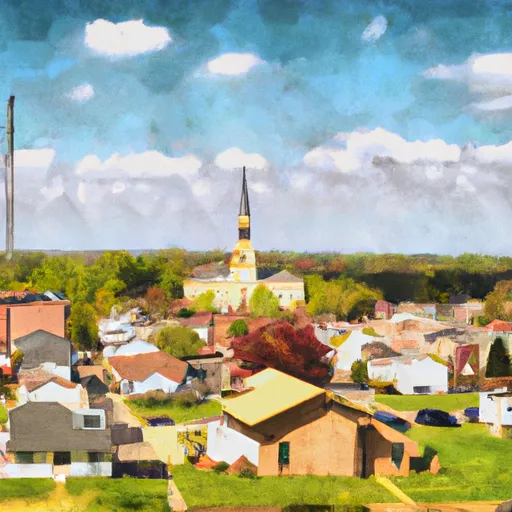-
 Snoflo Premium
Snoflo Premium
Get unlimited access to all our content
With no Ad interruptions! - Start Your Free Trial Login with existing account
West-Lebanon
Eden Index
Climate
8.1
•
Recreation
2.2
•
Community
1.7
•
Safeguard
4.4/10

West-Lebanon, Indiana is a picturesque town located in the northwestern part of the state. The climate in West-Lebanon is classified as humid continental, with four distinct seasons. Summers are warm and humid, with temperatures averaging around 80°F (27°C). Winters are cold and snowy, with temperatures dropping to around 30°F (-1°C). Spring and fall offer pleasant temperatures, making them ideal seasons for outdoor activities.
West-Lebanon is situated near the Wabash River, which serves as a vital hydrological feature. The river provides opportunities for fishing, boating, and canoeing. It also supports a diverse ecosystem with abundant wildlife and bird species. The river's tributaries, such as Shawnee Creek, contribute to the hydrology constituents of the area.
Outdoor enthusiasts will find numerous recreation opportunities in and around West-Lebanon. The town is surrounded by beautiful forests, offering opportunities for hiking, camping, and wildlife observation. Pine Hills Nature Preserve, located nearby, provides stunning views and hiking trails. Turkey Run State Park, a short drive away, offers rugged canyons, scenic trails, and opportunities for rock climbing, fishing, and camping.
Overall, West-Lebanon, Indiana promises a pleasant climate, diverse hydrology constituents, and a range of outdoor recreation opportunities for nature enthusiasts.
What is the Eden Index?
The Snoflo Eden Index serves as a comprehensive rating system for regions, evaluating their desirability through a holistic assessment of climate health, outdoor recreation opportunities, and natural disaster risk, acknowledging the profound impact of these factors on livability and well-being.
Climate Health Indicator (CHI): 8.1
West-Lebanon receives approximately
986mm of rain per year,
with humidity levels near 81%
and air temperatures averaging around
11°C.
West-Lebanon has a plant hardyness factor of
5, meaning
plants and agriculture in this region thrive during a short period during spring and early summer. Most
plants will die off during the colder winter months.
By considering the ideal temperature range, reliable water supplies, clean air, and stable seasonal rain or snowpacks, the Climate Health Indicator (CHI) underscores the significance of a healthy climate as the foundation for quality living.
A healthy climate is paramount for ensuring a high quality of life and livability in a region, fostering both physical well-being and environmental harmony. This can be characterized by ideal temperatures, reliable access to water supplies, clean air, and consistent seasonal rain or snowpacks.
Weather Forecast
Streamflow Conditions
Wabash
Area Rivers
Wabash
Snowpack Depths
Wabash
Reservoir Storage Capacity
Wabash
Groundwater Levels
Recreational Opportunity Index (ROI): 2.2
The Recreational Opportunity Index (ROI) recognizes the value of outdoor recreational options, such as parks, hiking trails, camping sites, and fishing spots, while acknowledging that climate plays a pivotal role in ensuring the comfort and consistency of these experiences.
Access to outdoor recreational opportunities, encompassing activities such as parks, hiking, camping, and fishing, is crucial for overall well-being, and the climate plays a pivotal role in enabling and enhancing these experiences, ensuring that individuals can engage in nature-based activities comfortably and consistently.
Camping Areas
| Campground | Campsites | Reservations | Toilets | Showers | Elevation |
|---|---|---|---|---|---|
| Ouabache Trails County Park | 45 | 446 ft | |||
| Prides Creek Co Park | None | 485 ft | |||
| Greene - Sullivan State Forest | None | 521 ft | |||
| Montgomery Bell State Park | 80 | 618 ft | |||
| Lincoln Trail | None | 412 ft | |||
| Meriwether Lewis | 32 | 963 ft | |||
| Sullivan County Park | 450 | 520 ft | |||
| Destiny Parks Military - Fort Campbell | None | 544 ft | |||
| Res 26 - Greene - Sullivan State Forest | 25 | 498 ft | |||
| Kimmell City Park | 10 | 415 ft |
Nearby Ski Areas
Catastrophe Safeguard Index (CSI):
The Catastrophe Safeguard Index (CSI) recognizes that natural disaster risk, encompassing floods, fires, hurricanes, and tornadoes, can drastically affect safety and the overall appeal of an area.
The level of natural disaster risk in a region significantly affects safety and the overall livability, with climate change amplifying these risks by potentially increasing the frequency and intensity of events like floods, fires, hurricanes, and tornadoes, thereby posing substantial challenges to community resilience and well-being.
Community Resilience Indicator (CRI): 1.7
The Community Resilience Indicator (CRI) recognizes that education, healthcare, and socioeconomics are crucial to the well-being of a region. The CRI acknowledges the profound impact of these elements on residents' overall quality of life. By evaluating educational resources, healthcare accessibility, and economic inclusivity, the index captures the essential aspects that contribute to a thriving community, fostering resident satisfaction, equity, and social cohesion.

